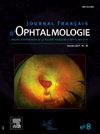Ocular surface evaluation in atopic dermatitis patients on dupilumab: A prospective observational study
IF 1.1
4区 医学
Q3 OPHTHALMOLOGY
引用次数: 0
Abstract
Purpose
To describe the ocular surface findings in atopic dermatitis patients treated with dupilumab.
Method
This is an observational study including atopic dermatitis patients treated with dupilumab from January 2018 to July 2019. At baseline, patients underwent dermatological and ophthalmological assessments and at least one other joint visit during the 6-month follow-up. Appointments were scheduled at baseline, 1, 3, and 6 months for ophthalmologists. Ocular assessment included past ocular history and symptoms, Ocular Surface Disease Index (OSDI) score, slit lamp examination, tear film Break Up Time and Schirmer's test. Atopic dermatitis severity scores were assessed at baseline and 3 and 6 months by dermatologists.
Results
Forty-six patients were included. Among them, 31 (67%) had preexisting ocular surface disease at baseline. Mean follow-up was 7.1 ± 1.6 months. At the 6-month endpoint, 8 patients (17%) developed newly diagnosed ocular surface disease; 13 patients (28%) experienced exacerbation of ocular surface disease; 8 patients (17%) had stable ocular surface disease, 10 patients (22%) experienced an improvement in their ocular surface disease on dupilumab, and 7 patients (15%) had no ocular surface disease from baseline to the endpoint. The presence of eyelid eczema at baseline was associated with the occurrence of dupilumab induced ocular surface disease. Only 3 patients (7%) had to discontinue treatment due to ocular adverse events.
Conclusion
Atopic dermatitis patients treated with dupilumab may develop polymorphic, potentially severe ocular surface disease. These results highlight the need for careful examination of the eyelids and globe of atopic dermatitis patients and early examination by ophthalmologists if conjunctivitis does not resolve with non-steroid eye drops.
Objectif
Décrire les atteintes de surface oculaire au cours des dermatites atopiques sous dupilumab.
Méthode
Il s’agit d’une étude observationnelle réalisée entre janvier 2018 et juillet 2019, chez des patients ayant une dermatite atopique et pour qui du dupilumab a été introduit. Le suivi ophtalmologique a été réalisé à l’inclusion, au 1er, 3e et 6e mois. L’ophtalmologue évaluait les antécédents et les symptômes oculaires, le score OSDI (Ocular Surface Disease Index), le segment antérieur en biomicroscopie, le BUT et réalisait un test de Schirmer. L’examen dermatologique déterminait le score de sévérité de la dermatite atopique à l’inclusion, au 3e et au 6e mois.
Résultats
Quarante-six patients ont été inclus. Trente et un (67 %) avaient dès l’inclusion une atteinte pré-existante de surface oculaire. Le suivi moyen était de 7,1 ± 1,6 mois. À 6 mois, 8 patients (17 %) ont développé une atteinte de surface oculaire ; 13 patients (28 %) ont eu une exacerbation de celle-ci ; 8 patients (17 %) sont restés stables, 10 patients (22 %) ont eu sous dupilumab une amélioration de leurs manifestations de surface oculaire et 7 patients (15 %) n’ont présenté aucun symptôme. La présence d’un eczéma des paupières à l’inclusion a été associée au développement d’une atteinte de surface induite par le dupilumab. Seuls 3 patients (7 %) ont dû interrompre le traitement en raison d’effets indésirables oculaires.
Conclusion
Au cours des dermatites atopiques sous dupilumab, les patients peuvent développer des atteintes de surface oculaire.
杜匹单抗治疗特应性皮炎患者眼表评价:一项前瞻性观察研究
目的探讨杜匹单抗治疗特应性皮炎患者的眼表表现。方法:本研究是一项观察性研究,纳入2018年1月至2019年7月接受杜匹单抗治疗的特应性皮炎患者。在基线时,患者在6个月的随访期间接受皮肤病学和眼科评估以及至少一次其他联合访问。在基线、1个月、3个月和6个月预约眼科医生。眼部评估包括眼部病史和症状、眼表疾病指数(OSDI)评分、裂隙灯检查、泪膜破裂时间和Schirmer试验。皮肤科医生在基线、3个月和6个月时评估特应性皮炎严重程度评分。结果纳入46例患者。其中31例(67%)在基线时已存在眼表疾病。平均随访7.1±1.6个月。在6个月的终点,8名患者(17%)出现新诊断的眼表疾病;13例(28%)出现眼表疾病加重;8名患者(17%)有稳定的眼表疾病,10名患者(22%)在dupilumab治疗后其眼表疾病得到改善,7名患者(15%)从基线到终点没有眼表疾病。基线时眼睑湿疹的存在与杜匹单抗诱发的眼表疾病的发生有关。只有3例(7%)患者因眼部不良事件而停止治疗。结论特应性皮炎患者接受杜匹单抗治疗后可能出现多形性、潜在的严重眼表疾病。这些结果强调了特应性皮炎患者需要仔细检查眼睑和眼球,如果结膜炎不能通过非类固醇滴眼液解决,需要眼科医生进行早期检查。目的:应用杜匹单抗治疗特应性皮肤炎,观察患者的皮肤表皮病变。msamthodeil’s agit d’une ·························Le suvii ophtalmologique a samuest rsamuest isis l 'inclusion, 1, 3, 3, 6, e mois。L ' ophthalmmologue samvaluales - antacimaciments et les symptômes oculaires, le score OSDI(眼表疾病指数),le segment antsamrieur en生物显微镜,le BUT et samalisit un test de Schirmer。L 'examen dermatologique determinait le得分de severite de la dermatite atopique L 'inclusion,非盟3 e等非盟6月。包括6名患者在内。三分之一(67%)的人认为存在一种表面眼病。(1)、(1)、(1)、(6)。À 6例,8例(17%)未见表面眼角膜病变;13例(28%)未出现一次细胞-ci加重;8例患者(17%)表现为静止的变性,10例患者(22%)表现为单纯的单抗性变性,7例患者(15%)表现为单纯的变性symptôme。包括一个与之相关联的一个与之相关联的一个与之相关联的一个与之相关联的一个与之相关联的一个与之相关联的个体。结果:3例(7%)患者未接受dû介入性治疗。结论使用杜匹单抗治疗特应性皮炎,可减少患者眼表皮肤病变的发生。
本文章由计算机程序翻译,如有差异,请以英文原文为准。
求助全文
约1分钟内获得全文
求助全文
来源期刊
CiteScore
1.10
自引率
8.30%
发文量
317
审稿时长
49 days
期刊介绍:
The Journal français d''ophtalmologie, official publication of the French Society of Ophthalmology, serves the French Speaking Community by publishing excellent research articles, communications of the French Society of Ophthalmology, in-depth reviews, position papers, letters received by the editor and a rich image bank in each issue. The scientific quality is guaranteed through unbiased peer-review, and the journal is member of the Committee of Publication Ethics (COPE). The editors strongly discourage editorial misconduct and in particular if duplicative text from published sources is identified without proper citation, the submission will not be considered for peer review and returned to the authors or immediately rejected.

 求助内容:
求助内容: 应助结果提醒方式:
应助结果提醒方式:


